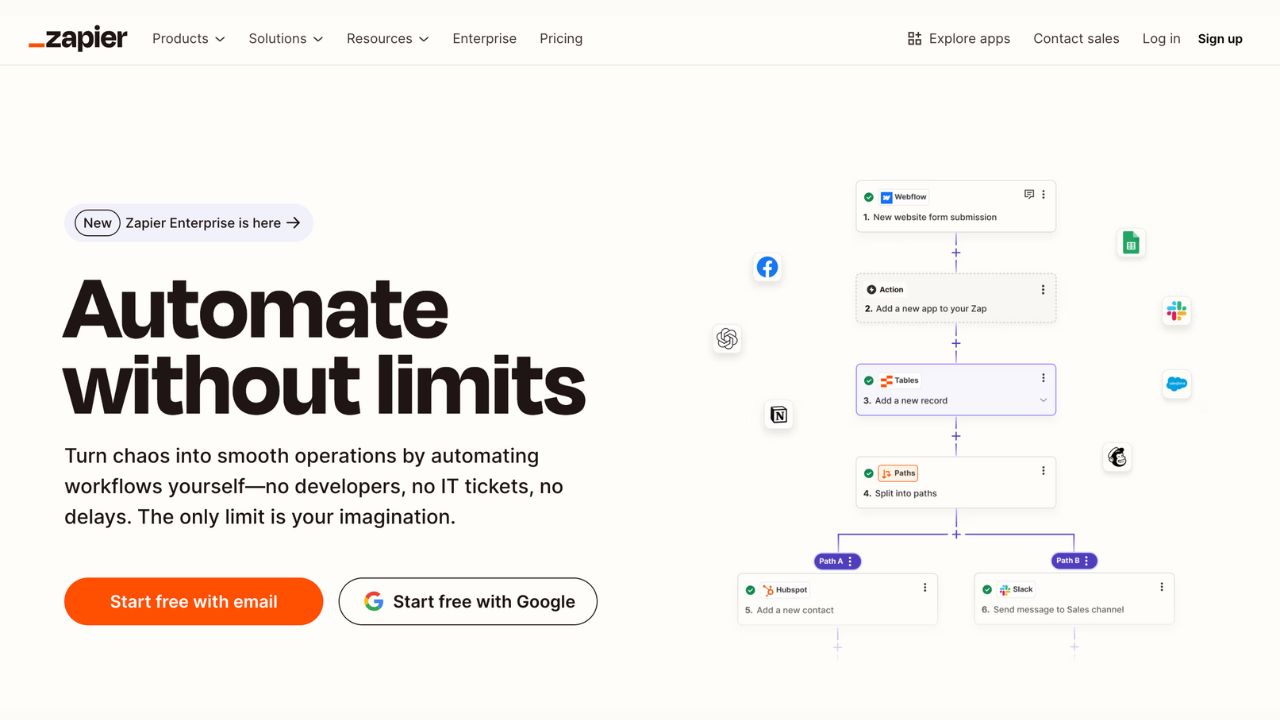
In today’s fast-paced work environment, every second counts. Yet, inefficiencies, scattered workflows, and disengaged employees continue to hold businesses back. The secret to overcoming these challenges? The right workforce tools.
As 2025 approaches, organizations must adapt to evolving workplace trends—remote collaboration, AI-powered automation, and employee engagement. This guide unveils ten cutting-edge productivity tools designed to optimize performance, streamline operations, and give your business a competitive edge in the new era of work. Let’s dive in!
The concept of workforce management has been shifted considerably. Businesses today operate in many locations, both domestic and international, as well as in remote settings. They need tools to address real business challenges. These tools promote collaboration, monitor effectiveness, and ensure employee satisfaction.
Some key reasons for the increased emphasis on workforce tools include:
Effective workforce planning in 2025 will involve tools that maintain clear communication, improve flexibility, and integrate seamlessly with existing systems.
Here’s a list of the best workforce tools designed to enhance productivity and efficiency:
The Employee App (TEA) Workforce Management Tool is an innovative system. It aims to boost communication, engage employees, and enhance productivity. Feedback is real-time, with instant alerts for management. This helps them stay updated on team performance and address potential issues quickly.
TEA assists businesses in analyzing their productivity trends so that any resource can be well managed. This tool is particularly useful since it caters to the needs of different types of teams, whether in-office or remote. This makes it compatible with other software, such as payroll systems and other HR software, hence enhancing force management.
TEA has a big advantage: it focuses on employees and offers user-friendly tools. This creates an ideal work environment. The TEA Workforce Management Tool should be mandatory for organizations that want to stay relevant in 2025. It promotes transparency and accountability.
Asana excels in project management. It helps businesses assign tasks, track progress, and achieve goals. With its user-friendly interface, Asana stands out. Users can choose from custom and premade templates. These templates are versatile, fitting industries like technology and healthcare.
The greatest strength of the platform is that it breaks down complex tasks into manageable pieces. This way, teams can set priorities, assign deadlines, and communicate with colleagues on the platform, thus avoiding long email threads. Integrating Asana with current software such as Slack, Google Drive, and Zoom makes the workflow more efficient.
Asana’s reporting and analysis tools are key for organizations using agile methodologies. They track project performance effectively. By linking team cooperation to corporate goals, Asana helps businesses stay efficient. This makes it a top choice for companies aiming to excel in 2025.
With its visually appealing Kanban boards, Trello is an optimal choice for teams of all sizes. The current Trello interfaces promote teamwork since it allows users to create boards, lists, and cards that represent projects and operations.
Precisely, versatility is one of its biggest advantages because it can be used both for personal and professional settings. Files can be uploaded, due dates can be set, and comments can be made on the task card, creating centralized expertise in the job details.
Trello also allows easy connectivity to other platforms, such as Slack, Microsoft Teams, and Dropbox, making it an additional application to existing solutions. Its mobile application helps remote teams to stay updated and track progress anytime, anywhere. In 2025, Trello’s ability to promote transparency and streamline workflows makes it a go-to solution for businesses worldwide.
Slack is a top communication tool for teams. It offers real-time messaging and file sharing and works with many other productivity tools. Its simple interface encourages collaboration no matter where users are working.
Slack features include a private channel for team chats and direct messaging for personal chats. It also integrates with third-party apps like Google, Asana, and Trello. Its search function lets users quickly find messages, files, and chats, saving time.
Slack helps teams in different time zones. Its notifications are organized by time, allowing users to focus without constant interruptions. In 2025, new AI features will offer insights and automation. These updates will improve how people interact and work together. Slack continues to be one of the best ways of managing the workforce efficiently.

Zapier is the best automation app for any organization, and it aims to reduce time-consuming tasks and increase productivity. Zapier lets users connect apps and services without any coding expertise so that they can automate workflows known as “Zaps.”
For instance, with Zapier, emails with attachments can be copied into the cloud storage automatically, customer inquiries in the CRM systems can be updated, or updates can be posted on the team’s chat. These automations help to save employees’ time for doing more important work.
By 2025, Zapier boasts over 5,000 applications, ranging from marketing applications like Mailchimp to customer support applications like Zendesk. It is convenient to use and has strong support, which can meet the demands of various businesses. Since automation is an essential element of today’s business processes, Zapier’s potential to connect different tools is invaluable.
Microsoft Teams is popular in hybrid work settings. It combines messaging, meetings, document sharing, and project management into one platform. Users can easily access documents, calendars, and email thanks to its integration with Microsoft 365. This makes collaboration with the team seamless.
It is a preferred choice for virtual meetings because the teams can organize video conferencing with breakout rooms and live captions. It also has features such as shared calendars and boards for tasks so that working on projects stays organized.
Microsoft Teams will add new AI features in 2025. These include real-time transcription and meeting insights. Its security is robust, with deep policies and enhanced end-to-end encryption. This makes it ideal for companies handling secure data. MS Teams is a key tool for managing today’s workforce. It integrates all applications in one place.
Monday.com excels in visualizing workflows, which makes it useful for organizations that practice any kind of agile methodologies. You can easily define its dashboards to track project timelines, allocate resources, and analyze bottlenecks.
It is also compatible with various tools such as Slack, Google Calendar, and Zoom to make sure all information in the project is well available. Its automation features, such as status updates and task reminders, reduce manual effort and improve efficiency.
Monday.com helps organizations gain actionable insights into team performance and project progress. For this reason, it suits small and large businesses, making it one of the best workforce solutions in 2025.
For companies that operate with high productivity and employee accountability, Hubstaff is an incredibly useful time-tracking app. It enables the managers to control the total hours worked by different employees, plan the working schedule of each project, and identify areas where resources are underutilized.
Hubstaff provides screenshot capture, activities tracking, and geofencing for teams working on-site. All these tools ensure that businesses have a proper understanding of how time is spent across the organization. Moreover, it is well integrated with the payroll, which simplifies payment processing, saving time and effort.
In 2025, Hubstaff will add more features. Advanced analytics will help businesses see deeper insights into productivity trends. Its focus on open disclosure and efficient work organization has made it a top tool. Organizations aiming to optimize workforce management find it very useful.
Workday is a global leader in cloud-based solutions for HR and financial management. Large businesses with complicated processes are eager to implement this type of software for its scalability and adaptability.
Workday offers to manage new hires, evaluate performance, and process payroll. It has built-in analytical capabilities that give businesses an understanding of workforce trends. For HR teams, Workday’s automation capabilities simplify processes like benefits enrollment and compliance reporting.
In 2025, Workday will expand its functionalities for mobile optimization and advanced analytics. It maintains its user-friendliness and data security to let businesses use it for their long-term workforce management.
Notion is a multi-functional tool that has two basic functionalities: note taking, task management, and database management. It is the one-stop shop for teams desirous of creating an efficient workflow system with seamless order.
The Notion, almost like Trello, offers template options where users can create project boards, databases, and documents. It has a simple layout and efficient search system, allowing a faster way of locating information.
For organizations in 2025, Notion collaboration tools guarantee that teams remain aligned, even in remote environments. The fact that you could use it in every single plan, from marketing strategy to product roadmaps, makes it quite useful to every workforce.
All of these tools have their own features and are focused on fulfilling certain needs. They are essential for business organizations that want to stay competitive.
It is important that an organization plans to implement some workforce tools to develop a good plan. Consider the following steps:
Know what you want and what you are setting out to do, whether it is improved communication, efficient processes, improved information management, etc.
Consult with employees, managers, and IT teams through discussion concerning the selection and implementation stage to foster constructive remarks.
Provide formal training to the team members, educating them on various tools to enhance their performance.
Use analytics to track the tool’s effectiveness and make adjustments as needed.
To get the most out of the tool, stay updated on the new features and updates.
Integrating workforce tools will enhance employee engagement and productivity.
Selecting the right workforce tools is crucial for organizations striving to thrive in 2025. These tools not only enhance productivity but also drive employee engagement through scalability, innovation, and user experience.
For instance, Slack facilitates real-time workplace communication, while theEMPLOYEEapp (TEA) streamlines internal communications, and improves employee connectivity. Each solution is designed to address specific challenges in modern work environments.
By staying ahead of emerging trends and strategically integrating these tools, organizations can enhance efficiency, foster a more connected workforce, and set the stage for long-term success.
Workforce tools are software applications that boost employee productivity. They help companies manage projects and track activity levels. These tools are crucial for success in hybrid and remote work models.
Employee management tools automate production and repetitive tasks. They also integrate communication channels and use monitoring tools for real-time project updates. These features help employees focus on important work, reduce manual errors, and ensure projects are completed on time.
Workforce software is applications that boost employee productivity. They help companies manage projects and track activity levels. These tools are crucial for success in hybrid and remote work models.
There are platforms such as Microsoft Teams, Slack, or Notion that allow communication, organizing meetings, and document collaboration for remote or hybrid teams. They often include mobile applications through which employees work from any location.
Automation features include alerts and notifications, status updates, syncing data from one tool to the other, and creating workflows for repetitive tasks. For instance, Zapier connects apps to automate processes like updating CRM records or notifying teams of project changes.